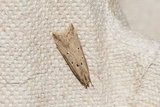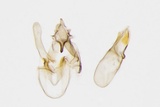Brachmia inornatella (Douglas, 1850) Species
Last modified: Nov. 30, 2025, 1:06 p.m.
A rare species in the northern part of Belgium and very rare in the southern part of the country.
Details
- Classification
- Family: Gelechiidae > Subfamily: Dichomeridinae > Genus: Brachmia > Species: Brachmia inornatella
- Vernacular names
- Poeltjespalpmot (NL), Fen Snout, Fen Crest (EN), Teich-Palpenmotte (DE)
- First mention in Belgium
- Janmoulle E. 1958b. Espèces nouvelles pour la faune belge (suite). — Lambillionea 58: 73–75. On page 73.
- Status
-
Native
Distribution
Caterpillar
Head dark brown; prothoracic plate brown, mottled darker posteriorly with a narrow, whitish medial division; abdomen whitish, suffused pale brownish; a more or less disntinct, narrow brown dorsal line; anal plate sub-oval, brown; prolegs semi-translucent greyish-brown; pinacula brown (Gregersen & Karsholt 2022).
Bionomics
The larva lives in the upper section of a dead stem of the food plant. It hibernates in the stem. There are no obvious external signs in the winter where it feeds within the upper section of a dead stem.
The moths become active from late afternoon and around dusk and later come to light.
Flight periods
The adults fly usually from mid-May towards late August, with a peak during June.
Observed on
- Host plant (species):
- Phragmites australis
The larva lives on Phragmites australis.
Habitat
It occurs in fens, marshes and other wetland biotopes.


